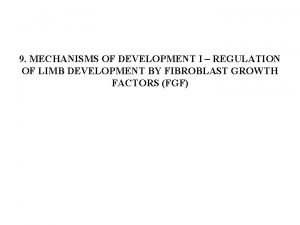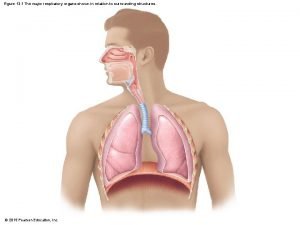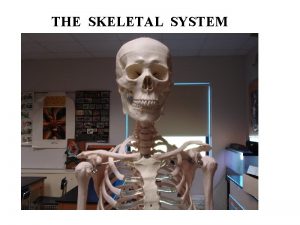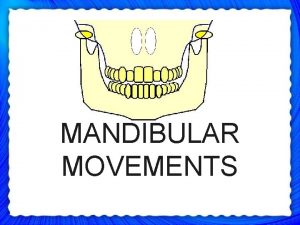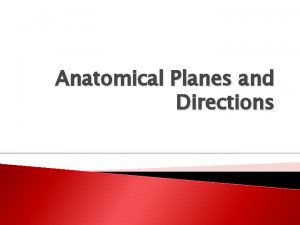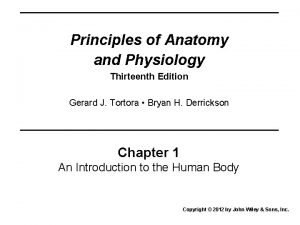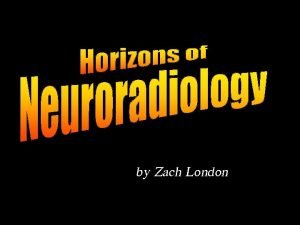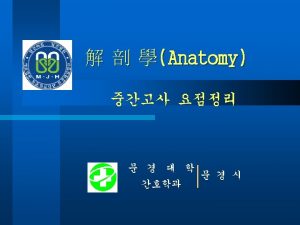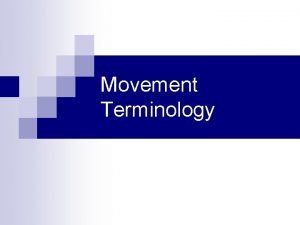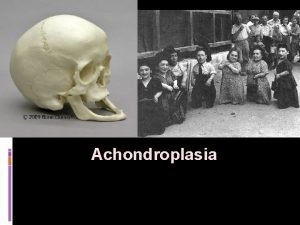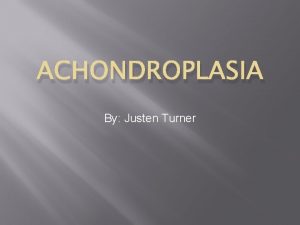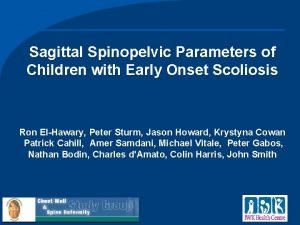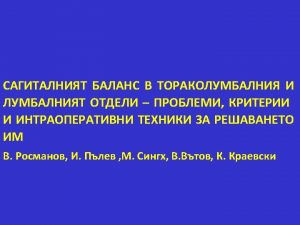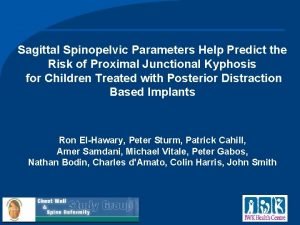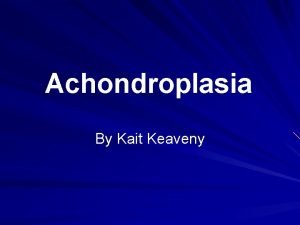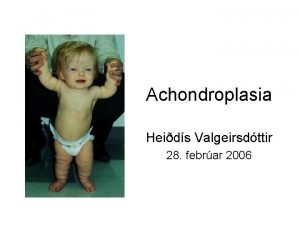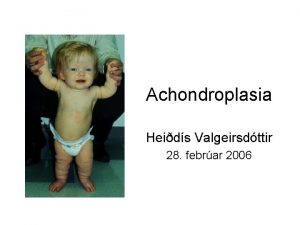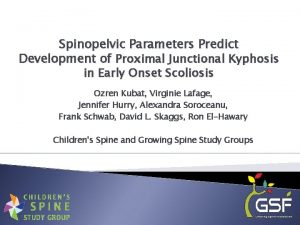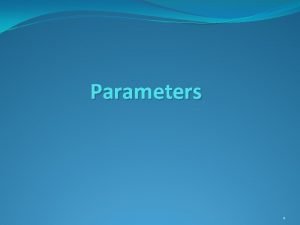Sagittal Spinopelvic Parameters in Children with Achondroplasia Suken















- Slides: 15

Sagittal Spinopelvic Parameters in Children with Achondroplasia Suken A. Shah MD, Oussama Abousamra, MD; Tyler M. Kreitz, MD; John A. Heydemann, MD; Kenneth J. Rogers, Ph. D; Colleen Ditro, DNP, CPNP; William G. Mackenzie, MD

Background Study Population • Sagittal spinal deformity is common in children with achondroplasia • Records of all children (315 children) with achondroplasia, seen at our institution between 2004 and 2015, were reviewed. • Little data on the normative parameters • Children who had surgery (33 children) on their thoracolumbar spine were excluded. • The aim of this study is to report the natural history of sagittal spinopelvic parameters in children with achondroplasia • 745 Lateral spine radiographs in the standing position were reviewed. • Only one radiograph per patient per year was reviewed.

Radiographic Measurements • Thoracic Kyphosis T 5 -T 12 • Lumbar Lordosis L 1 -S 1 • Thoracolumbar Kyphosis T 10 -L 2 • Sacral Slope • Pelvic Tilt • Pelvic Incidence • T 1 Pelvic Angle • Sagittal Balance

Longitudinal Analysis • 81 Children with a minimum follow up of 5 years. • Mean follow up 8. 7 years (5 -19 years). • Between age 4. 4 years and 13. 1 years. • LL, TLK, PI, TPA, and SVA changed significantly. Children with minimum 5 First Radiograph Last Radiograph p values year follow up (81 Children) Mean SD Age 4. 4 3. 3 13. 1 4. 3 <0. 0001 TK 18 12 16 10 0. 221 LL 57 17 63 18 0. 037 TLK 22 15 12 13 <0. 0001 SS 48 12 52 13 0. 058 PT -5 13 -3 14 0. 259 PI 43 15 49 16 0. 016 TPA -5 11 -9 8 0. 010 SVA 7 28 -8 26 0. 0004

Longitudinal Analysis • 81 Children with a minimum follow up of 5 years. • Mean follow up 8. 7 years (5 -19 years). • Between age 4. 4 years and 13. 1 years. • LL, TLK, PI, TPA, and SVA changed significantly. Children with minimum 5 First Radiograph Last Radiograph p values year follow up (81 Children) Mean SD Age 4. 4 3. 3 13. 1 4. 3 <0. 0001 TK 18 12 16 10 0. 221 LL 57 17 63 18 0. 037 TLK 22 15 12 13 <0. 0001 SS 48 12 52 13 0. 058 PT -5 13 -3 14 0. 259 PI 43 15 49 16 0. 016 TPA -5 11 -9 8 0. 010 SVA 7 28 -8 26 0. 0004

Longitudinal Analysis • 81 Children with a minimum follow up of 5 years. • Mean follow up 8. 7 years (5 -19 years). • Between age 4. 4 years and 13. 1 years. • LL, TLK, PI, TPA, and SVA changed significantly. Children with minimum 5 First Radiograph Last Radiograph p values year follow up (81 Children) Mean SD Age 4. 4 3. 3 13. 1 4. 3 <0. 0001 TK 18 12 16 10 0. 221 LL 57 17 63 18 0. 037 TLK 22 15 12 13 <0. 0001 SS 48 12 52 13 0. 058 PT -5 13 -3 14 0. 259 PI 43 15 49 16 0. 016 TPA -5 11 -9 8 0. 010 SVA 7 28 -8 26 0. 0004

Longitudinal Analysis • 81 Children with a minimum follow up of 5 years. • Mean follow up 8. 7 years (5 -19 years). • Between age 4. 4 years and 13. 1 years. • LL, TLK, PI, TPA, and SVA changed significantly. Children with minimum 5 First Radiograph Last Radiograph p values year follow up (81 Children) Mean SD Age 4. 4 3. 3 13. 1 4. 3 <0. 0001 TK 18 12 16 10 0. 221 LL 57 17 63 18 0. 037 TLK 22 15 12 13 <0. 0001 SS 48 12 52 13 0. 058 PT -5 13 -3 14 0. 259 PI 43 15 49 16 0. 016 TPA -5 11 -9 8 0. 010 SVA 7 28 -8 26 0. 0004

Longitudinal Analysis • 81 Children with a minimum follow up of 5 years. • Mean follow up 8. 7 years (5 -19 years). • Between age 4. 4 years and 13. 1 years. • LL, TLK, PI, TPA, and SVA changed significantly. Children with minimum 5 First Radiograph Last Radiograph p values year follow up (81 Children) Mean SD Age 4. 4 3. 3 13. 1 4. 3 <0. 0001 TK 18 12 16 10 0. 221 LL 57 17 63 18 0. 037 TLK 22 15 12 13 <0. 0001 SS 48 12 52 13 0. 058 PT -5 13 -3 14 0. 259 PI 43 15 49 16 0. 016 TPA -5 11 -9 8 0. 010 SVA 7 28 -8 26 0. 0004

Longitudinal Analysis Children with minimum 10 • 19 Children with a minimum follow up of 10 years • Mean follow up 13. 8 years (1019 years). • Between age 3. 3 years and 17 years. • LL, TLK, PT, and PI changed significantly. First Radiograph Last Radiograph p values year follow up (19 Children) Mean SD Age 3. 3 2. 4 17 3. 3 <0. 0001 TK 16 10 14 11 0. 579 LL 49 19 61 16 0. 037 TLK 25 16 12 14 0. 012 SS 44 14 49 14 0. 283 PT -11 13 2 13 0. 002 PI 33 13 51 16 0. 0004 TPA -8 13 -7 7 0. 785 SVA 7 16 -4 34 0. 233

Longitudinal Analysis Children with minimum 10 • 19 Children with a minimum follow up of 10 years • Mean follow up 13. 8 years (1019 years). • Between age 3. 3 years and 17 years. • LL, TLK, PT, and PI changed significantly. First Radiograph Last Radiograph p values year follow up (19 Children) Mean SD Age 3. 3 2. 4 17 3. 3 <0. 0001 TK 16 10 14 11 0. 579 LL 49 19 61 16 0. 037 TLK 25 16 12 14 0. 012 SS 44 14 49 14 0. 283 PT -11 13 2 13 0. 002 PI 33 13 51 16 0. 0004 TPA -8 13 -7 7 0. 785 SVA 7 16 -4 34 0. 233

Radiographs of a Boy with Achondroplasia 1 year of age 2 years of age 3 years of age 9 years of age

Radiographs of a Girl with Achondroplasia 1 year of age 1. 8 years of age 2. 6 years of age 4 years of age

Cross Sectional Analysis Lumbar lordosis Pelvic Incidence Thoracolumbar kyphosis

Conclusions • Sagittal spinal curves in children with achondroplasia are interrelated in a complementary mechanism to support and maintain an economical, well balanced, posture. • Reduction of thoracolumbar kyphosis is compensated for by hyperlordosis at the lumbosacral level. • Pelvis alignment and hip positioning are directly affected by this compensatory mechanism.

Conclusions • Significant changes occur early in life suggesting the importance of early attention to sagittal malalignment to prevent any possible clinical effects of severe hyperlordosis. • Deeper understanding of the pathology underlying thoracolumbar kyphosis, as well as the segmental alignment of the sagittal spine is essential to regulate the compensatory curves while preventing persistent or progressive kyphosis.
 Achondroplasia
Achondroplasia Achondroplasia
Achondroplasia Figure 13-1
Figure 13-1 Transvers
Transvers Coronal suture
Coronal suture Posselt envelope of motion
Posselt envelope of motion Medial plane
Medial plane Transvers eksen
Transvers eksen Sagittal suture
Sagittal suture Figure 16-7 is a sectional view of the ovary
Figure 16-7 is a sectional view of the ovary Stomach physiology
Stomach physiology Coronal vs sagittal
Coronal vs sagittal Transforce appliance
Transforce appliance Median and sagittal plane
Median and sagittal plane Terminology of fundamental movements
Terminology of fundamental movements Horizontal frontal sagittal
Horizontal frontal sagittal
